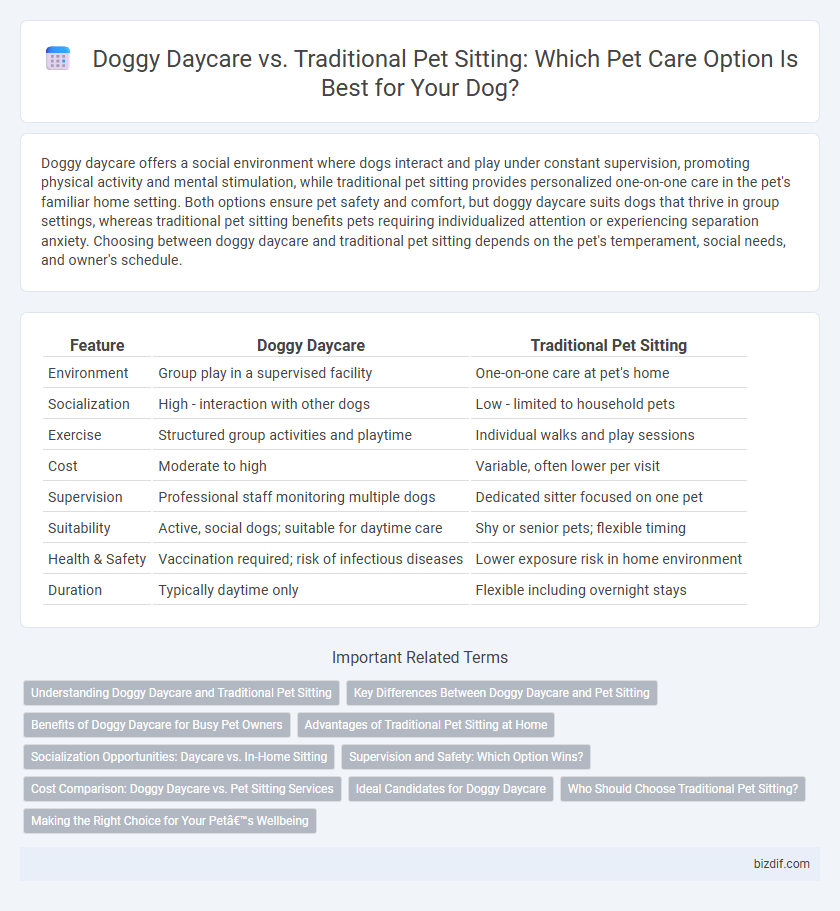Doggy daycare offers a social environment where dogs interact and play under constant supervision, promoting physical activity and mental stimulation, while traditional pet sitting provides personalized one-on-one care in the pet's familiar home setting. Both options ensure pet safety and comfort, but doggy daycare suits dogs that thrive in group settings, whereas traditional pet sitting benefits pets requiring individualized attention or experiencing separation anxiety. Choosing between doggy daycare and traditional pet sitting depends on the pet's temperament, social needs, and owner's schedule.
Table of Comparison
| Feature | Doggy Daycare | Traditional Pet Sitting |
|---|---|---|
| Environment | Group play in a supervised facility | One-on-one care at pet's home |
| Socialization | High - interaction with other dogs | Low - limited to household pets |
| Exercise | Structured group activities and playtime | Individual walks and play sessions |
| Cost | Moderate to high | Variable, often lower per visit |
| Supervision | Professional staff monitoring multiple dogs | Dedicated sitter focused on one pet |
| Suitability | Active, social dogs; suitable for daytime care | Shy or senior pets; flexible timing |
| Health & Safety | Vaccination required; risk of infectious diseases | Lower exposure risk in home environment |
| Duration | Typically daytime only | Flexible including overnight stays |
Understanding Doggy Daycare and Traditional Pet Sitting
Doggy daycare offers supervised socialization and exercise for dogs in a structured environment, promoting mental stimulation and physical activity. Traditional pet sitting involves personalized care in the pet's home, providing comfort and reducing stress through familiar surroundings. Both services cater to different pet needs, with daycare emphasizing social interaction and pet sitting focusing on individualized attention.
Key Differences Between Doggy Daycare and Pet Sitting
Doggy daycare provides a social environment where dogs interact with other pets under professional supervision, promoting exercise and behavioral development. Traditional pet sitting offers personalized, one-on-one care in the pet's home, reducing stress by maintaining familiar surroundings. While doggy daycare operates on a group schedule, pet sitting adapts to the owner's specific timing and individual pet needs.
Benefits of Doggy Daycare for Busy Pet Owners
Doggy daycare provides busy pet owners with reliable daytime supervision, ensuring pets receive social interaction and regular exercise, which supports their physical and mental health. The structured environment reduces separation anxiety and destructive behavior by keeping pets engaged with trained staff and other dogs. This service offers peace of mind for pet owners who face demanding schedules, knowing their pets are safe, stimulated, and cared for throughout the day.
Advantages of Traditional Pet Sitting at Home
Traditional pet sitting at home offers personalized one-on-one care tailored to each pet's routine, reducing anxiety associated with new environments. Pets stay in their familiar surroundings, maintaining consistent feeding, exercise, and sleeping patterns essential for their well-being. This method minimizes exposure to illnesses common in group settings, ensuring safer and healthier care.
Socialization Opportunities: Daycare vs. In-Home Sitting
Doggy daycare provides extensive socialization opportunities by allowing pets to interact with multiple dogs in a supervised environment, enhancing their social skills and reducing anxiety. Traditional in-home pet sitting offers personalized attention and comfort but limits exposure to other animals, which may reduce chances for social development. Choosing between the two depends on a dog's temperament, social needs, and owner preferences for interaction versus individualized care.
Supervision and Safety: Which Option Wins?
Doggy daycare offers continuous, professional supervision in a controlled environment designed to reduce risks and enhance safety through trained staff and secure facilities. Traditional pet sitting provides individualized attention in a familiar home setting, which can minimize stress but may lack constant oversight depending on the sitter's availability. For pet owners prioritizing comprehensive safety and active monitoring, doggy daycare often presents the superior option.
Cost Comparison: Doggy Daycare vs. Pet Sitting Services
Doggy daycare typically charges between $20 and $40 per day, offering socialization and exercise for pets, while traditional pet sitting rates range from $15 to $50 per visit depending on the location and services provided. Daycare centers may require full-day payments, making them cost-effective for owners seeking daily care, whereas pet sitting fees vary for single visits or extended stays, often including personalized one-on-one attention. Comparing annual expenses, dog owners using daycare five days a week can spend around $5,000 to $10,000, while pet sitting costs fluctuate with frequency but generally remain higher for frequent, individualized care.
Ideal Candidates for Doggy Daycare
Doggy daycare is ideal for high-energy dogs requiring socialization and structured activity, such as young puppies and active breeds like Border Collies or Labrador Retrievers. It suits owners with demanding work schedules who seek a safe, supervised environment to prevent behavioral issues caused by loneliness or boredom. Dogs needing regular interaction and mental stimulation benefit significantly from the group play and professional care offered in a daycare setting.
Who Should Choose Traditional Pet Sitting?
Traditional pet sitting is ideal for pet owners seeking personalized, one-on-one care in the comfort of their pet's familiar environment, reducing stress and anxiety. It suits pets with special needs, senior pets requiring medication administration, or those who do not adapt well to social settings like doggy daycare. Owners who prefer flexible scheduling and individualized attention typically benefit most from traditional pet sitting services.
Making the Right Choice for Your Pet’s Wellbeing
Doggy daycare provides socialization opportunities and supervised playtime that traditional pet sitting may lack, promoting mental and physical stimulation for your dog. Traditional pet sitting offers personalized, one-on-one care in a familiar home environment, reducing stress and anxiety for pets with separation issues. Evaluate your pet's temperament, social needs, and daily routine to make the right choice for their overall wellbeing and happiness.
Doggy daycare vs Traditional pet sitting Infographic

 bizdif.com
bizdif.com